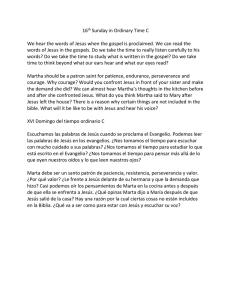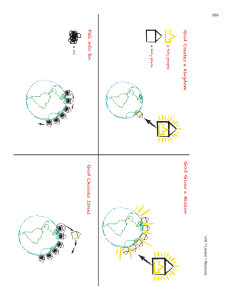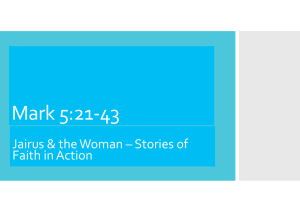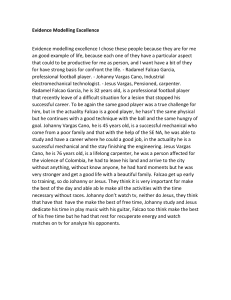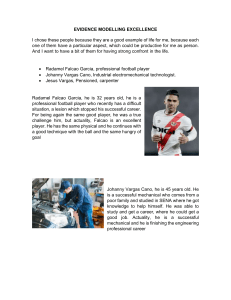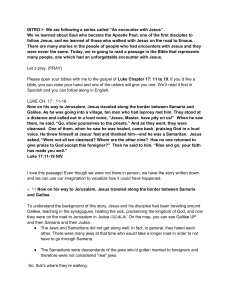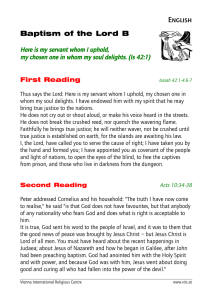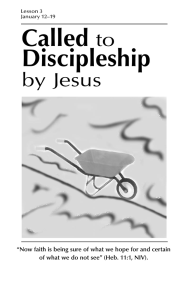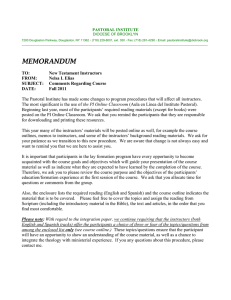Virgin Birth - Fundación Otras Ovejas de Argentina
Anuncio
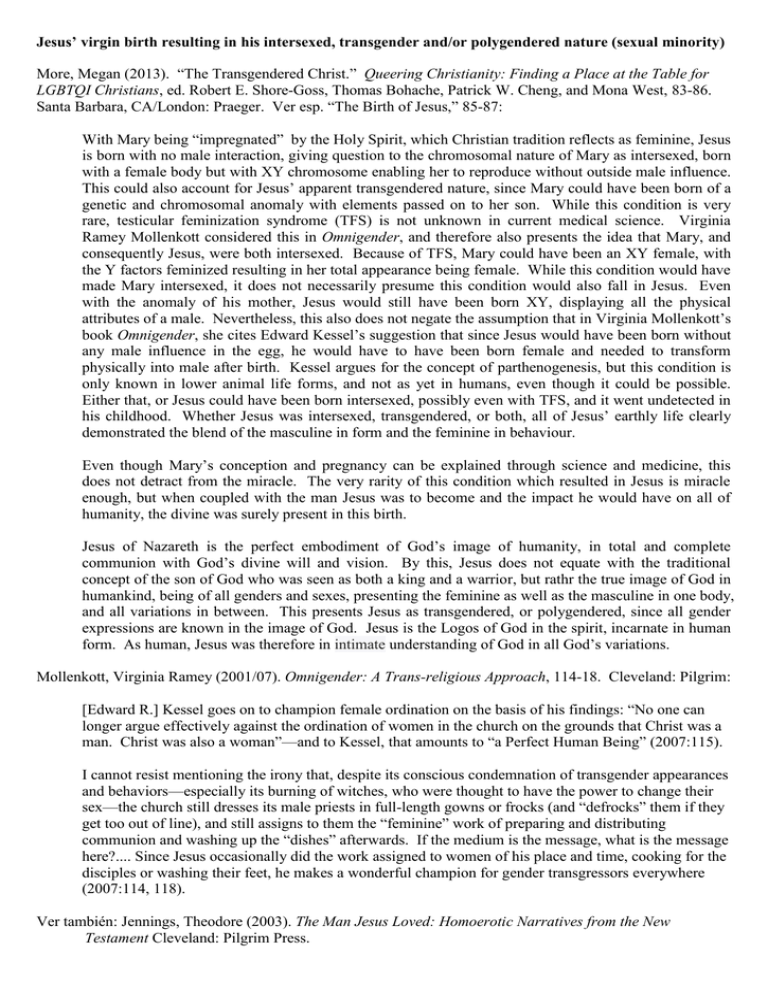
Jesus’ virgin birth resulting in his intersexed, transgender and/or polygendered nature (sexual minority) More, Megan (2013). ―The Transgendered Christ.‖ Queering Christianity: Finding a Place at the Table for LGBTQI Christians, ed. Robert E. Shore-Goss, Thomas Bohache, Patrick W. Cheng, and Mona West, 83-86. Santa Barbara, CA/London: Praeger. Ver esp. ―The Birth of Jesus,‖ 85-87: With Mary being ―impregnated‖ by the Holy Spirit, which Christian tradition reflects as feminine, Jesus is born with no male interaction, giving question to the chromosomal nature of Mary as intersexed, born with a female body but with XY chromosome enabling her to reproduce without outside male influence. This could also account for Jesus’ apparent transgendered nature, since Mary could have been born of a genetic and chromosomal anomaly with elements passed on to her son. While this condition is very rare, testicular feminization syndrome (TFS) is not unknown in current medical science. Virginia Ramey Mollenkott considered this in Omnigender, and therefore also presents the idea that Mary, and consequently Jesus, were both intersexed. Because of TFS, Mary could have been an XY female, with the Y factors feminized resulting in her total appearance being female. While this condition would have made Mary intersexed, it does not necessarily presume this condition would also fall in Jesus. Even with the anomaly of his mother, Jesus would still have been born XY, displaying all the physical attributes of a male. Nevertheless, this also does not negate the assumption that in Virginia Mollenkott’s book Omnigender, she cites Edward Kessel’s suggestion that since Jesus would have been born without any male influence in the egg, he would have to have been born female and needed to transform physically into male after birth. Kessel argues for the concept of parthenogenesis, but this condition is only known in lower animal life forms, and not as yet in humans, even though it could be possible. Either that, or Jesus could have been born intersexed, possibly even with TFS, and it went undetected in his childhood. Whether Jesus was intersexed, transgendered, or both, all of Jesus’ earthly life clearly demonstrated the blend of the masculine in form and the feminine in behaviour. Even though Mary’s conception and pregnancy can be explained through science and medicine, this does not detract from the miracle. The very rarity of this condition which resulted in Jesus is miracle enough, but when coupled with the man Jesus was to become and the impact he would have on all of humanity, the divine was surely present in this birth. Jesus of Nazareth is the perfect embodiment of God’s image of humanity, in total and complete communion with God’s divine will and vision. By this, Jesus does not equate with the traditional concept of the son of God who was seen as both a king and a warrior, but rathr the true image of God in humankind, being of all genders and sexes, presenting the feminine as well as the masculine in one body, and all variations in between. This presents Jesus as transgendered, or polygendered, since all gender expressions are known in the image of God. Jesus is the Logos of God in the spirit, incarnate in human form. As human, Jesus was therefore in intimate understanding of God in all God’s variations. Mollenkott, Virginia Ramey (2001/07). Omnigender: A Trans-religious Approach, 114-18. Cleveland: Pilgrim: [Edward R.] Kessel goes on to champion female ordination on the basis of his findings: ―No one can longer argue effectively against the ordination of women in the church on the grounds that Christ was a man. Christ was also a woman‖—and to Kessel, that amounts to ―a Perfect Human Being‖ (2007:115). I cannot resist mentioning the irony that, despite its conscious condemnation of transgender appearances and behaviors—especially its burning of witches, who were thought to have the power to change their sex—the church still dresses its male priests in full-length gowns or frocks (and ―defrocks‖ them if they get too out of line), and still assigns to them the ―feminine‖ work of preparing and distributing communion and washing up the ―dishes‖ afterwards. If the medium is the message, what is the message here?.... Since Jesus occasionally did the work assigned to women of his place and time, cooking for the disciples or washing their feet, he makes a wonderful champion for gender transgressors everywhere (2007:114, 118). Ver también: Jennings, Theodore (2003). The Man Jesus Loved: Homoerotic Narratives from the New Testament Cleveland: Pilgrim Press. Tanis, Justin (2003). Trans-Gendered: Theology, Ministry and Communities of Faith. Cleveland: Pilgrim: Jesus himself undergoes a remarkable process of transition through his death and resurrection. He is transformed in his life through his encounter with others [Mark 7:24-30], is transfigured upon the mountaintop [Mark 9:2-13; see Moses, Ex 34:29-35; believers, 2 Cor 3:7-4:18; Phlp 3:12-4:1], and finally transformed through death from the living Jesus to the resurrected Christ [Mark 16:1-8; 1 Cor 15:35-57], who is unrecognizable to those who knew him until he reveals himself [Luke 24:13-35, 3649; John 20:10-18]. Within his body, he contains both finite life and eternal life both death and resurrection, in the way that transgendered people embody both male and female. The holiness of Christ is that he is both/and, both human and divine, both mortal and eternal. When we are baptized, we are baptized into this changing transformational Christ, who rises above human limitations of gender, class, and nation, as Paul declares in Galatians 3:28 (2003:142). Mateo Solamente en Mateo, Jesús expone su versión de la "ciencia de eunucología" (Mateo 19:11-12; John Nolland 2005: 777-81; Thomas Boache 2006:507-11). La Ley de Moisés, que prohibía la participación de los eunucos en el culto (Deut. 23:1), tal vez quiso eliminar la práctica pagana de este tipo de "sacrificio". Después del exilio, cuando muchos varones israelitas sufrieron la castración como prisioneros de guerra, el Tercer Isaías declaró que Dios aceptaba a los eunucos (Isaías 56:1-8). La buena fama de Nehemías, probablemente eunuco por su oficio en Persia, tal vez produjo el cambio radical en la actitud. Pero Jesús va más lejos aún, al señalar la existencia de tres tipos de eunucos: (1) los que sufren la castración, (2) los que nacen así y (3) los que escogen no casarse por consideración al reino de Dios. Estos diversos "eunucos" no deben ser despreciados sino aceptados como el nuevo modelo en el reino de Dios –e incluyeron líderes solteros como Juan el Bautista, Jesús y Pablo, quienes tomaron el lugar de los sacerdotes casados de Israel (Craig S. Keener 1999:469-472; Brant James Pitre 1999; Deirdre Good 1999). Pitre señala que en la antigüedad los eunucos eran marginados, pero a veces también eran funcionarios imperiales. Como en la India moderna, en la Biblia "eunuco" bien podría ser un eufemismo, un término genérico para minorías sexuales de varios tipos, sobre todo los que no procrean hijos, o de la falta de interés heterosexual o la incapacidad física. Bibliografìa: Eunucos Ayalon, David (1999). Eunuchs, Caliphs, and Sultans: A Study in Power Relationships. Jerusalem: Magnes. Everhart, Janet. ―Hidden Eunuchs of the Hebrew Bible‖. Society of Biblical Literature 2002 Seminar Papers, 137-155. Atlanta: SBL, 2002. Kuefler, Mathew. The Manly Eunuch: Masculinity, Gender Ambiguity, and Christian Ideology in Late Antiquity. Chicago: University of Chicago, 2001. Malik, Faris http://www.well.com/user/aquarius/ sitio muy extenso sobre eunucos Moxnes, Halvor (2003). Putting Jesus in His Place: A Radical Vision of Household and Kingdom. Louisville: Westminster John Knox. Ringrose, Kathryn (2003). The Perfect Servant: Eunuchs and Social Construction of Gender in Byzantium. Chicago: University of Chicago. Ver los libros de Deuternomio, Nehemías, Ester, Isaías 56-66, Daniel, Mateo, Hechos. Sobre eunucos en Mateo, ver las ponencias de Deidre Good, "Eunuchs in the Matthean Community", y de Brant James Pitre, "Marginal Elites: Matthew 19:12 and the Social and Political Dimensions of Becoming 'Eunuchs for the Sake of the Kingdom'", resumidas en AARSBL Abstracts 1999:227-228.

